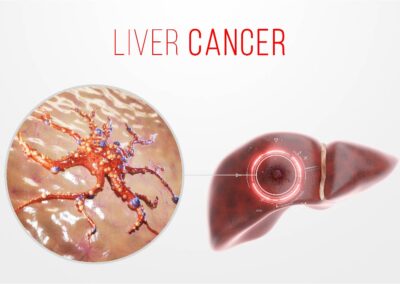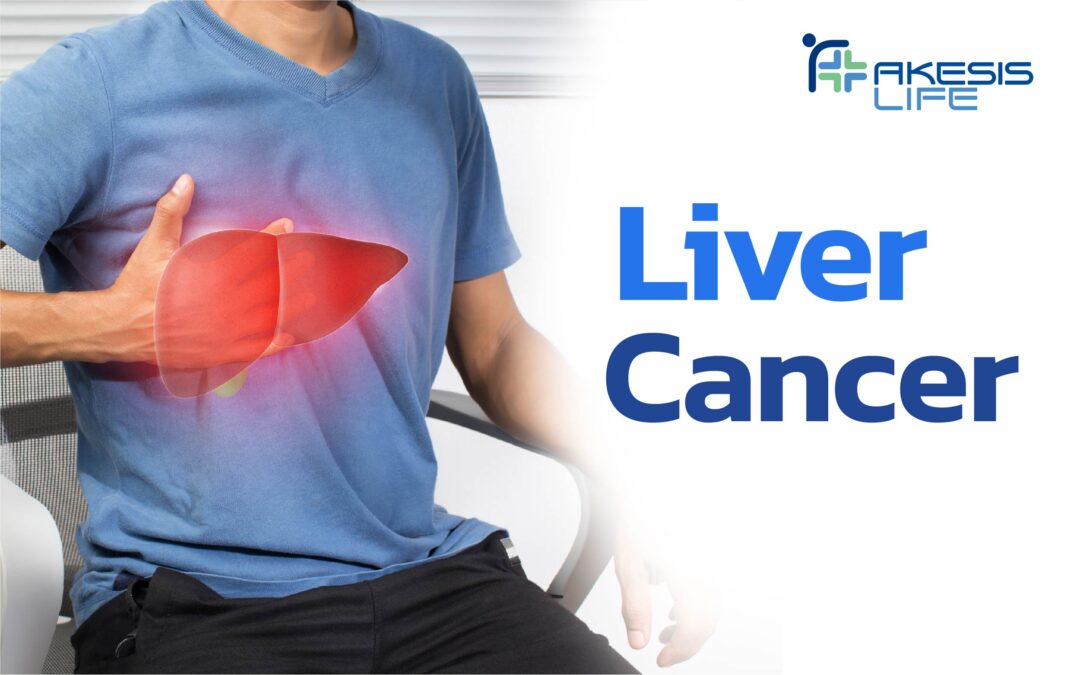According to the World Cancer Research Fund International (2020), liver cancer ranks as the sixth most common cancer globally. However, data from Thailand’s Department of Medical Services (2021) indicate that hepatocellular carcinoma (HCC) and cholangiocarcinoma (CCA) are the most prevalent cancers in the country. Due to late-stage diagnosis—often only after symptoms appear—liver cancer carries a high mortality rate. Understanding risk factors and undergoing appropriate screening are therefore crucial in reducing both incidence and mortality.
Hepatocellular Carcinoma (HCC)
HCC originates from mutated hepatocytes (liver cells) that undergo abnormal proliferation. It is the most common form of primary liver cancer. Diagnosis can be made via CT scan, MRI, or liver biopsy.

Risk factors include cirrhosis, chronic hepatitis B and C infections, obesity, and metabolic syndrome. Exposure to certain toxins also increases risk, such as:
- Aflatoxins from fungal contamination in corn, peanuts, and grains
- Nitrosamines found in processed meats like sausages and bacon
- Arsenic in contaminated water or fertilizers
- Vinyl chloride used in plastic manufacturing
- Smoking and alcohol consumption
Surveillance is recommended every 6 months for high-risk individuals using AFP (Alpha-fetoprotein) blood tests and liver ultrasound.
Treatment strategy is often based on the Barcelona Clinic Liver Cancer (BCLC) staging system, which considers:
- Tumor burden
- Patient performance status
- Liver function/reserve
| Stage | Treatment Options | Median Survival | Treatment Goal |
| A – Early | Ablation, Resection, RFA, Liver Transplant | >5 years (40 – 70%) | Curative 30% |
| B – Intermediate | TACE | 11 – 20 months | Palliative |
| C – Advanced | Sorafenib | 11 – 20 months | Palliative |
| D – End | Symptomatic treatment | <3 months | Palliative |
Intrahepatic Cholangiocarcinoma (ICCA)
ICCA arises from mutated cholangiocytes (bile duct cells) and is the second most common type of primary liver cancer. It is diagnosed primarily via CT or MRI.
Chronic bile duct inflammation is a major cause, with risk factors including:
- Liver fluke infection
- Primary sclerosing cholangitis (PSC)
- Congenital bile duct abnormalities such as Caroli’s disease, congenital hepatic fibrosis, choledochal cyst
- Exposure to Thorotrast (a radiographic contrast agent)
- Obesity

Currently, there is no standardized global guideline for liver cancer screening due to its rarity in many countries. However, Thailand—particularly the northeastern region—has a significantly higher incidence due to the consumption of raw fermented fish, which increases the risk of liver fluke infection.
At-risk individuals should undergo liver ultrasound and blood tests for tumor markers (CA 19-9 and CEA). Abnormal findings warrant further evaluation with CT or MRI.
Staging and treatment follow the TNM classification (Tumor size, Node involvement, Metastasis). The standard treatment is surgical resection. For unresectable cases, treatment may include:
- Chemotherapy
- Locoregional therapy (Radiation, RFA, TACE)
- Targeted therapy
Stage | Treatment Options | Median Survival | Treatment Goal |
| I | Curative Resection | 5-year survival 40% | Curative |
| II | Non-curative Resection with adjuvant therapy | 5-year survival 20% | Palliative |
| III | Locoregional therapy Chemotherapy | RF/TACE: 15 months, Chemo: 12 months | Palliative |
| IV | Chemotherapy | – | Palliative |
Treatment-Related Adverse Effects
Liver cancer treatments carry the risk of liver failure due to collateral damage to surrounding liver tissues. The disease and its treatment can also lead to malnutrition, impaired digestion, dysbiosis (gut microbiome imbalance), reduced detoxification capacity, and weakened immunity. These effects lower the body’s ability to tolerate treatment, thereby reducing therapeutic response.
Surgical complications may involve injury to nearby organs such as blood vessels, gallbladder, pancreas, and intestines.
Targeted therapies may cause side effects like skin rash, hand-foot blisters, diarrhea, abdominal pain, nausea, vomiting, hair loss, dry itchy skin, and oral mucositis.

The Role of Integrative Medicine in Liver Cancer
Integrative oncology aims to address liver cancer holistically using a multidisciplinary approach. This includes:
- Nutritional therapy
- Enzyme therapy
- Ozone therapy
- Immunotherapy
- Cell therapy
These treatments seek to:
- Enhance treatment response
- Minimize side effects
- Repair organ damage
- Reduce recurrence
By targeting underlying carcinogenic factors and modifying the tumor microenvironment (TME), integrative approaches help:
- Detoxify the liver and intestines
- Reduce inflammation
- Regenerate liver cells
- Rebalance the gut microbiota
- Improve digestion
- Deliver intravenous nutrients
- Use repurposed drugs to enhance standard therapies


